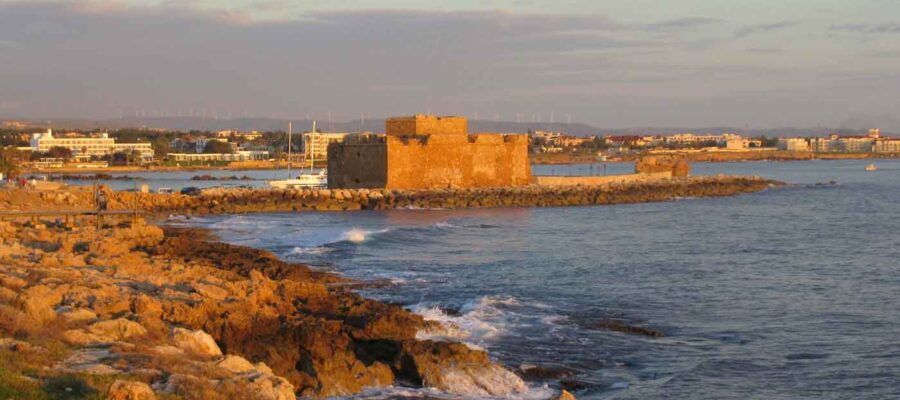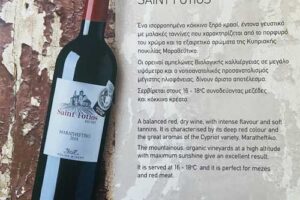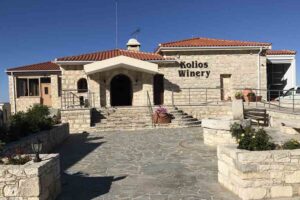A Short History of Cyprus
The story of Cyprus, an island located in the far eastern end of the Mediterranean Sea, begins 10,000 years ago in the Neolithic Age (8200 – 3800 BC). During this time, the first indications of permanent settlement appear. The first Cypriots lived in basic single room dwellings, utilized stone tools and utensils, and fashioned jewelry from picrolite. Their diet consisted mainly of fish, various cereals, lamb and goat’s meat. Pottery has been found dating back 7,000 years, and going into the Chalcolithic Age (3800 – 2400 BC) copper mining emerged, an element so closely linked to the Island that the word copper is derived from the Greek name for the Island, Kupros. Significantly, evidence of wine making dates to this period!
Beginning in the late Chalcolithic Age and the Early Bronze Age (2400 – 1900 BC) and continuing into the Middle Bronze Age (1900 – 1650 BC), gradual but important changes emerge. Dwellings began to be built with multiple rooms in an oblong shape. Jewelry began to be made from copper. Agriculture became more sophisticated with the introduction of the plough. Organized cemeteries became the norm. However, life continued in small isolated villages, and contact with the surrounding Mediterranean cultures remained limited.
Going into the Late Bronze Age (1650 – 1050 BC), pronounced changes occurred. The small isolated villages are joined by significant coastal towns, as communication and trade with Egypt, the Middle East, the Aegean, and other areas of the Eastern Mediterranean developed and expanded. It is the Aegean connection, starting in the late 13th century BC, that firmly established Greek culture on the Island, with the arrival of multiple waves of Mycenaean Greek settlers.
Moving into Historic Times, beginning from 1050 – 480 BC and coinciding with the Iron Age, the roots of Hellenization became firmly established, even as the Island began to realize its position at the crossroads of the civilizations in the region. During this time, the Greek art periods known as the Geometric Period (1050-750 BC) and the Archaic Period (750 – 480 BC) occurred, profoundly influencing the art, culture, and religion of Cyprus. The Greeks established the principle city-kingdoms of Cyprus (Salamis, Kition, Amathous, Kourion, Idalion, Palaipafos, Marion, Soloi and Tamassos). The arrival of the Phoenicians in the Geometric Period and the conquest of the Island by the Assyrians, followed by the Egyptian Pharaoh Amasis, during the Archaic Period all left their cultural marks, but the Greek influence remained dominant.

As the Classical Period began (480 – 323 BC), Cyprus fell under the rule of the Persian Empire, but nevertheless maintained a large degree of independence. The influence of Greek culture actually increased during this period, especially in terms of religion and art. As Alexander the Great advanced east, Persian rule ended around 310 BC. The Hellenistic Period (323-30 BC) brought Ptolemy as the ruler of Cyprus. The Ptolemaic kingdom strongly influenced the art of Cyprus, especially in sculpture, ceramics, and statuette making. During this time, Cyprus was largely used as a military base, with exploitation of it’s natural resources, including copper, timber for ships, and olives and wheat.
The Hellenistic Period ended and the Roman Period (58 BC – 330 AD) began. Starting around 30 BC, Cyprus came under Roman rule. It is during this time that Cyprus began a 300 year run of prosperity due to the trade that developed via the Roman Empire. Additionally to the exploitation of the copper mines, decorative pottery was one of the main exports. As with past cultural influences, Roman arts and crafts heavily influenced Cypriot jewellery and glassware. Significantly, it is during the Roman Period that Cyprus began its road to Christianity due to the evangelism of Saints Paul and Barnabas starting around 40 – 45 AD.


The passing of the Roman Period ushered in the Byzantine Period (330 – 1191 AD). The Christian Church in Cyprus strengthened and increased its influence considerably starting early on in this period, becoming an independent entity from the main Eastern Church headquartered in Constantinople. Peace and prosperity marked the majority of this period, the exception being the Arab Muslim raids that began in 648 – 649 continuing periodically until ending in 965 when finally defeated by Emperor Nicephorus II Phocas. Many castles, fortifications, and churches were built in this period. The silk industry also developed and thrived during this time, becoming one of the most prosperous industries on the Island. Ecclesiastical art and architecture made their mark as well.

We now enter the Frankish Period (1192 – 1489 AD). During the Third Crusade, in 1191 Richard the Lionheart, King of England, recognized the strategic value of Cyprus. He conquered the Island, making it into a logistical base supplying the Crusaders. While in Cyprus, Richard married and the wedding feast included the Cypriot wine Commandaria, the oldest named wine still in production and the oldest Appellation of Origin in the world. Here Richard declared Commandaria “the king of wines and the wine of kings”. Richard sold the Island to the Knights Templars; after briefly owing it they gave it back to Richard due to an uprising on the Island. Richard then sold Cyprus to the French nobleman Guy de Lusignan in 1192, ushering in the Frankish Period (or Lusignan Period) which lasted nearly 300 years. The Catholic Christian Church replaced the Orthodox Christian Church as the official Christian institution on the Island, and after the fall of Jerusalem in 1291, Cyprus remained the only bastion of Christianity in the East. Cyprus established itself as the principle trading post in the region, with strong ties to powerful Western trading cities such as Venice and Genoa, and by the 14th century the economy was thriving. Cyprus produced and exported many high quality products including sugar, wine and other agricultural goods, woven and laced textile products, and glazed ceramic ware. Many Gothic-style churches and castles were built during this time.

The Venetian Period (1489 – 1571 AD) followed the Frankish Period when Catarina Cornaro, the last queen of Cyprus, ceded the Island to Venice in 1489. The Venetians strategically turned Cyprus into a strong point that effectively allowed the free movement and supply of Venetian ships in the Eastern Mediterranean. The ports of Larnaka and Lemesos developed and expanded during this time, as Cypriot agricultural, textile, and salt exports boomed. It is during this time that the famous lace industry of the Village of Lefkara was born. In the midst of this prosperity, however, storm clouds began to gather as the Ottoman Empire expanded into Greek lands. When the Ottomans occupied the island of Rhodes in 1522, the Venetians fortified the capitol city of Lefkosia and strengthened the fortifications around the sea side city of Ammochostos. Despite this effort, Ammochostos fell to the Ottomans in 1571, ushering in the next period of Cypriot history.
The Ottoman Period (1571 – 1878 AD) marked the first time a Muslim community established itself on Cyprus. As happened during all the previous Periods, the Muslim influence made its mark on the Island in art and architecture with the building of mosques and other structures, such as the famous “Turkish baths”. Despite this, the Orthodox Church of Cyprus was granted liberal privileges, and given both religious and political authority over the Island. This eventually encouraged a resurgence of Greek cultural, social, and economic activity starting in the early 18th century, displacing the Roman influences of the previous three Periods. As the Ottoman Empire waned, the Greek influence grew. Greek Cypriots contributed to the Greek War of Independence of 1821 against the Ottoman Empire, and the resulting independent Greek state. As the 19th century progressed, European trade and diplomatic ties expanded, greatly effecting the social fabric of the Island as urbanization set in. The rebirth of independent Greece reunited Cypriot Greek culture with mainland Greek culture, inspiring the first yearnings of nationalist sentiments on Cyprus.

Ottoman Empire and its influence on Cyprus.
1878 – 1960 AD marks the British Period. In 1878, a secret treaty ceded Cyprus from the Ottoman Empire to the British Empire. The Cypriots expected life would improve in these new circumstances, and they held out hope for unification with Greece. Instead Britain ruled the Island with an iron hand. Following a failed uprising event in October 1931, the Empire struck back, imposing even harsher colonial rule. The Cypriots never lost hope, and by 1950 the quest for unification continued, resulting in a referendum vote where nearly 96% of Greek Cypriots voted in favor of it. The British still refused, so from 1955 – 1959 the Greek Cypriots waged an all-out struggle against British Colonial rule. This struggle brought about the end of British rule, but not union with Greece. It did however result in the establishment of the independent Republic of Cyprus, with it’s first president elected on December 13th, 1959.
On August 16th, 1960, the Republic of Cyprus officially came into being. It became a member of the United Nations, the Commonwealth, the Council of Europe, and the Non-aligned Movement, and on May 1st, 2004, Cyprus joined as a full member of the European Union. To this day Britain maintains two military bases on the Island. Since its Independence Day, Cyprus has endured two conflicts with Turkey, first in 1964 and the second in 1974, both involving the Turkish-Cypriot minority. The 1964 conflict was mainly inter-communal within the confines of the Island. The 1974 conflict was much more serious, with the Turkish military invading and illegally occupying the northern third of the Island, where to this day they remain and the problem unresolved by the international community. Lefkosia (Nicosia) is the only divided capital in the world. Despite these challenges, Cyprus has developed into a modern society while still maintaining its strong traditions and culture. It is an archeologists dreamland, where ruins, artifacts, and other treasures from every Historic Period mentioned here are found everywhere. When will the next Period begin and what will it bring?


Turkish zone. After the fall of the Berlin Wall in 1991, Lefkosia became the only
divided capital in the world. United Nations peacekeeping troops patrol this area.
Note the Turkish flag in the background.






Recent Comments